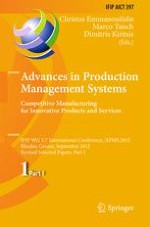2013 | Buch
Advances in Production Management Systems. Competitive Manufacturing for Innovative Products and Services
IFIP WG 5.7 International Conference, APMS 2012, Rhodes, Greece, September 24-26, 2012, Revised Selected Papers, Part I
herausgegeben von: Christos Emmanouilidis, Marco Taisch, Dimitris Kiritsis
Verlag: Springer Berlin Heidelberg
Buchreihe : IFIP Advances in Information and Communication Technology
